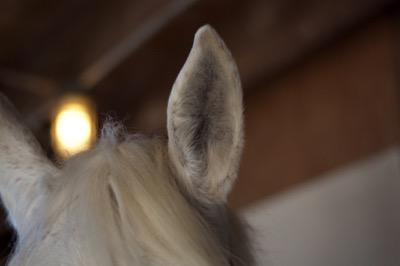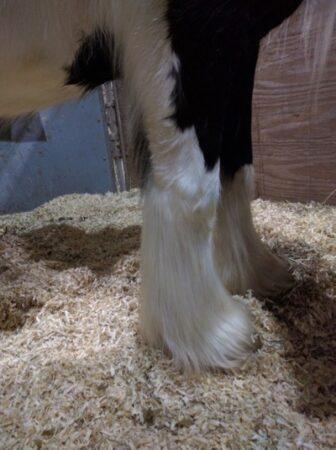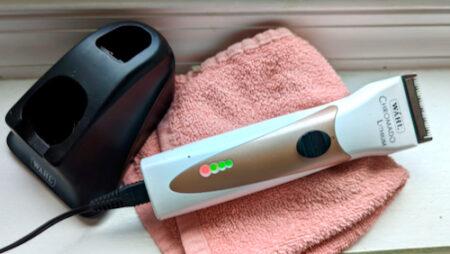10 Minute Touch-Up With Trimmers
Sometimes, we can groom our horses to a mirror finish, but they still seem rough around the edges. Using trimmers to banish stray hairs and wayward fuzz from your horse is easy. And just like all clipping, the touch-up with trimmers is optional.
Why trim or clip your horse?
- There’re two big reasons to trim or clip your horse – their health and comfort. And trimming falls into those categories, too! Although many show horses are clipped for aesthetic reasons, you don’t have to have a show horse to play around with trimmers.
Use trimmers to make your horse more comfortable.
- Bridle paths are an absolute must for most horses that have a mane. When the mane is under the bridle, it creates a bump and, therefore, a pressure point. The clipped path allows your tack to cover the poll evenly and more comfortably.

Trimmers are handy for reaching into smaller areas with lots of hair chaos.
Help your horse’s skin
- Some skin problems, like equine pastern dermatitis (EPD), are greatly exacerbated by hair, moisture, and dirt. Removing some or all of a horse’s feathers helps prevent EPD, and makes treatment much more effortless.
- Other skin problems, like mystery dermatitis under thick manes or sores around elbows, do much better when you remove the bulk of the hair.
What you could trim on your horse
Bridle path
- As mentioned, this trimming of the mane helps your bridle fit. So easy, so fast, and so much better. And using trimmers ensures the quietest clip with minimal vibrations.
Ears
- Some horses have every last hair in and around their ears zipped off. While this look is sometimes the “show standard” for horse shows, it leaves your horse’s ear vulnerable to insects and sunburn.
- To tidy things up, you could go all out or trim the wispy edges of the ear. Use fly masks with ear coverings if you remove all the ear hair, inside and out.

You can leave the fuzz or zip the fuzz.
Tail
- You might bang your horse’s tail depending on your discipline. When you give your horse a blunt cut at the end of their tail, everything gets wider. Banging is super for thin tails, but things get too wide for thicker tails. Banged tails are also not great for the hunter ring and other disciplines where the tail is natural.
- You may also choose to tidy up the top of your horse’s tail with clippers. When the side hair is shortened, the butt cheeks look more muscular. An alternative would be to use scissors to avoid accidentally removing too much tail hair that high up the tailbone.

You can see the clipped sides of this horse’s tail dock.
Fetlocks
- Trimming fetlock hair may stir some controversy! Fetlock hair and feathers are not always best for your horse. Mud, dirt, moisture, bacteria, fungus, and who-knows-what love to grow around fetlocks.
- Longer hair and feathers can trap all those things, cooking up a case of EPD for your horse. Longer hair also covers the coronary band, which can hide wounds and the beginnings of quarter cracks.
- If you tidy up those lower legs, you can remove all the feathers or the bulk of hair – your choice. Sometimes short hair is better, especially if your horse’s skin is prone to irritations and infections.

You can trim this if you like! Or not.
Elbows
- The elbow area of your horse can be a hot mess of hair, wrinkles, and sweat. Then, movement and tack-tugging can get involved. Sometimes this is worse in winter as the longer hair sweats up and gets caught by the girth more easily.
- Some horses with girth itch or girth galls do best when the elbow area is clipped. Meds are easier to apply, the area dries faster, and any special medicated shampoos from your vet go directly to the skin.
Think twice before clipping whiskers
- A horse’s whiskers and eyebrows are vibrissae. These specialized hairs are sensory hairs, which communicate information about their surroundings to your horse’s brain. A horse can’t see under their chin, but the whiskers can.
- Some show organizations, like the FEI, forbid trimming whiskers and vibrissae of competing horses under that organization’s rules. If you don’t show at the FEI level, it’s not an issue. However, some countries also forbid whisker trimming, and it doesn’t matter if that horse shows.

5 – in – 1 trimmer blades show you exactly how much hair will remain.
Best methods to use your horse trimmers
- Start with clean skin and hair. For most tidy-ups, you don’t need to give your horse a full bath; you can spot-bathe the areas you will trim. But I don’t recommend washing your horse’s ears (ever); there’s too much of a risk that water ends up deep in the ear canal.
- Ensure your trimmers are charged and ready to go. Cordless strimmers have internal batteries or removable batteries. Removable batteries and internal batteries usually charge on a dock. BUT! If your cordless trimmers have internal batteries, you can use the dock’s cord directly in the clipper body to charge and trim simultaneously.
- Pick the best clipper blade for the area you are clipping. Most trimmers have a 5-in-1 blade that can adjust from a #9 to a #40. The higher the number, the more hair is removed. A #9 or 10 is perfect for small tidies of arrant hair.
- You can clip close to the skin or not. Pushing your clippers through the hair against the growth direction gives a close clip. Flipping the clippers upside down and raking them with the growth direction allows you to remove most of the hair, but not all.

These clippers have an internal battery that can be charged in a port or by connecting directly to the charging cord.
- If you trim ears, use pom-poms to prevent falling hair from landing in the canal.
- Provide fly and skin protection if you clip ears or lower legs, especially if the hair is white with pink skin underneath. Fly boots and fly masks with ear covers are affordable and comfortable for your horse. And they ward off pesky flies, so bonus.
And never forget the cardinal rule of horse clipping – it’s optional, and you should do what’s best for your horse. That is all.
Read the Complete Guide to Horse Clipping here
and Horse Clipping for Beginners here
Click these links to shop for horse supplies. As an Amazon Associate, I earn from qualifying purchases, which are not a penny more for you. I couldn’t be more grateful for your support! You can also visit my Amazon storefront here: PEG storefront.
This cordless trimmer is powerful and comes with the 5-in-2 blade system for versatility.
This is my favorite clipper - It's great for body clipping, trace clipping, and trimming. Cordless for the win!
This new KM cordless clipper has constant power, no matter the haircoat, and rechargeable batteries that last 3 hours. It's quiet, and the wide blade makes clipping faster.
This spot-on product kills and repels ticks and helps with mosquito control.
This style is great for riding!
Fair warning - this spray has an odd aroma - but it works for some types of flies!
Sweet itch is best battled by not letting those annoying midges bite your horse.
For horses with sweet itch and other insect allergies, more coverage is better.
LeMieux has more colors than the paint section of a hardware store. I promise they have one you like!
These fly masks are fantastic for protecting ears and eyes, and do great under halters and grazing muzzles to stop rubs and hairless patches.
Use code 15PROEQUINE for a sitewide discount on muzzles, halters, accessories, and slow feeders.
These are like the popular Shoo Fly leggings.
Thank you!





























































